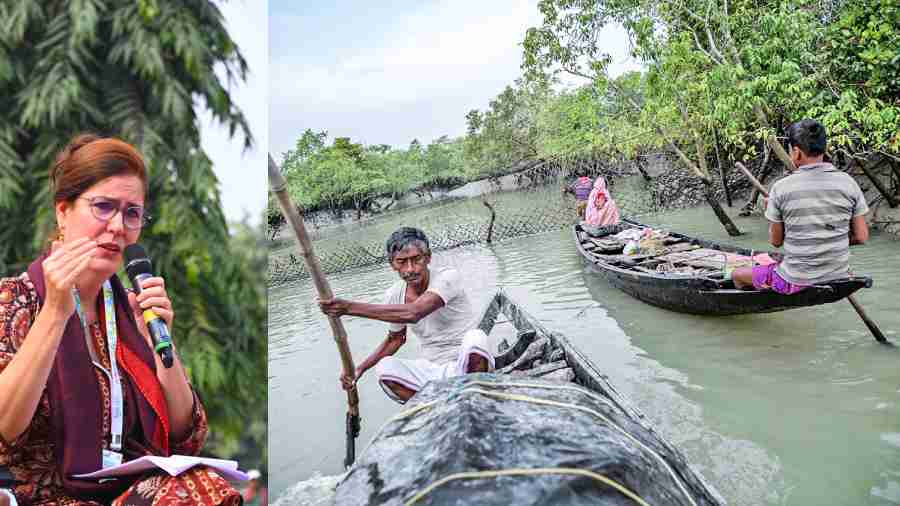Annu Jalais was eight years old when she visited Basanti island in the Sunderbans for the first time. Her parents worked in an Indian NGO and the family had visited one of their colleagues’ home in Basanti. “Later,” she says, “My father Leo Jalais, along with his architect friend Sobhanlal Bonnerjee, built the first cyclone shelter of the Sunderbans. What I found interesting were the stories I heard about encounters with tigers.”
At the time of this interview, Jalais is in town to participate in a literary meet. She continues about how she returned to the Sunderbans in 1988, as part of a nature study camp with her school. On this trip, she met R.L. Brahmachari, one of the foremost scientists of his time working on tiger pheromones along with two or three others.
There was a lot of debate and discussion those days among scientists about why the tigers of this geography, even when young, were attacking humans. “Some said it had to do with the fact that this was a tidal country. The entire forest area got flooded and tigers couldn’t mark their perimeter with their urine. Others said that it was because the water was brackish, tigers needed human blood for a certain dietary balance. Scientists were surprised that young, healthy tigers were lifting people off boats,” Jalais recalls.
The government had ordered for freshwater ponds to be dug in the forest to check killings. Government officials also left gur (molasses) near these ponds in the hope that it would sweeten the predator’s nature. Says Jalais, “They distributed masks free of cost to the islanders.” Tigers usually attack from behind, these masks of a human face were worn on the back of the head to confuse the animal. But the scientists at the nature study camp said the masks did not quite work.
These seminal influences motivated Jalais to return to the area to write her doctoral thesis on the Sunderbans many years later.
When she started doing research work there in 1999, government officials told her it was futile developing the place because the islands were part of the moving “active” delta and that it was difficult to build bridges or jetties because the land would shift with rivers changing course. “People were not talking about climate change then and yet there was a fatalism about the place,” reminds Jalais.
She speaks about the Sunderbans intimately. The shrines of Bonbibi, Manasa and dargahs of pirs and gazis, all in close proximity to each other, people singing Jishu kirtans, the migratory patterns of the people. All talk has a way of becoming tiger talk.
Once upon a time, migration was seasonal, but now it is more long-term. The pandemic brought many people home. Not able to feed their children, they turned to the forest for fish and wood. From a pre-pandemic average of five tiger-related deaths every year, the number shot to 20 in 2020.
Says Jalais, “Earlier they counted the tigers by pugmarks and sometimes they counted double, but now they count the tigers with drones. In 2021, the census takers reported that there were 96 tigers.”
The Sunderbans has a high tiger count and one of the theories behind this fact is that neither the British nor the Indian princes could go tiger-hunting in the Sunderbans, which is why they survived. “The British and the rajas used to hunt on elephant back. But you can’t take elephants to the swampy Sunderbans,” adds Jalais. She thanks the gods for that.
Did Project Tiger make a difference to the number of tigers? Jalais replies, “Probably. But what it did for sure was give jobs to the people there; it sensitised people to the need to conserve tigers. It also changed the islanders’ perception of tigers.”
Jalais talks about the Marichjhapi massacre. Before coming to power in Bengal in 1977, the CPI(M) leadership promised they would bring back the East Bengali refugees living in Dandakaranya.
But once 35,000 people arrived, the Left Front government asked them to leave. What followed was a bloody massacre that left at least 200 refugees dead. Jalais says, “What also happened, in the minds of the people there, was that suddenly tigers became first-class animals and they, the people, became second-class citizens.”
Jalais has written a lot about the Sunderbans — the human-nonhuman interface; environment and climate change; religious identity and migration; caste and social justice. She has to say that one of the first people to write about this geography was Frenchman Francois Bernier, way back in the 17th century. “He passed through the forest and said that the boatmen warned him he would be the first one to be killed by the tiger because he was the stoutest,” says Jalais, who is of French descent herself.
She talks about the people who inspire her — the late Bikash Roychoudhury who wrote The Moon and the Net, Amitav Ghosh, Tony K. Stewart who translated the entirety of the Bonbibi Johuranama. The long list continues and includes younger scholars and colleagues
Jalais’s next project has to do with the mental health of the islanders. She says, “The first time I heard that someone can die of bhoy or dread was in the Sunderbans.”











